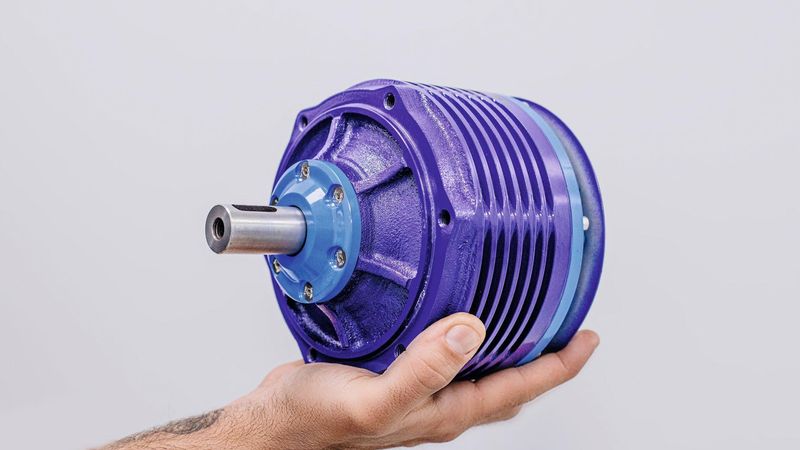Driving game-changing E-mobility development
Article #4 Altair Startup Series. Simulation is helping startups set the direction of the e-mobility industry.
This is the fourth article of a 6-part series about the way simulation software can enable startups to innovate with agility and speed. The series includes case studies and deep dives into simulation technology and application.
The electrification of the automotive industry or e-mobility is being implemented at full speed. To meet the pace demanded by the climate crisis, governmental goals, and consumer interest, the industry calls for continuous innovation to establish the infrastructure and achieve electric vehicle (EV) performance and affordability. The pace of conventional product development cannot get us there, so digital design tools, including cutting-edge simulation, are required.
What’s the hurry?
A driving factor for the accelerated move toward e-mobility is the climate crisis. Transportation contributes to 27% of the United States greenhouse gas emissions.[1] Many companies aim to be net-zero carbon emitters by 2040, requiring a shift to electric energy for all their vehicles, from heavy-duty trucks to business cars.[1]
Second, gas prices around the globe continue to rise. Filling up the tank of an internal combustion engine (ICE) vehicle can cost twice as much as it did a few years ago.[2] As a result, the demand for electric vehicles (EVs) is rising. EV sales around the world has increased two-fold.[3]
Established OEMs (original equipment manufacturers) vie to remain competitive in this market by developing their existing technology to meet customer needs and environmental goals. However, the advent of cloud computing, data intelligence, and agile economic models has enabled startups to compete within the market.
EVR Motors sees an opportunity
Israel-based EVR Motors Ltd. is a relatively new player in e-mobility. Beginning in 2012, the company developed wind turbine generators. With the increasing public interest in e-mobility EVR began to move its focus to vehicle electrification. They adjusted their roadmap when public taste favored e-mobility and then developed an innovative electric motor called TS–RFPM (Trapezoidal Stator Radial Flux Permanent Magnet Motor) based on new, patented technology that provides superior power and torque density—all at lower production costs.
While the power flows in the opposite direction with these two machine types, the hardware—rotor, coils, magnets—is similar. EVR now produces radial-flux permanent magnet (PM) electric machines for power conversion in EVs, hybrid vehicles, motorbikes, and industrial applications.
Breaking the mold
Traditionally, automotive engineers apply a standard motor technology called Radial Flux Permanent Magnet Motor topology (RFPM). EVR opted to create an entirely new topology—resulting in a completely new type of motor for the EV industry called the TS-RFPM topology. The result is a smaller and lighter motor than the industry standard that incorporates three-dimensional trapezoidal teeth and windings. Even more impressive, in some configurations, the TS-RFPM is rare-earth metal—free, seriously contributing to a greener electric future.

EVR delivers a successful e-motor
EVR’s unique electromagnetic design presented simulation challenges since engineers could not rely on the same approaches used with the traditional RFPM technology. To overcome these challenges, EVR selected a software package from the simulation company Altair because of its specific tools and functions related to motor design and refinement.
EVR engineers required robust multiphysics and optimization tools to refine the TS-RFPM topology before prototyping could begin. Electric motor design is constrained by numerous parameters, including electromagnetic and NVH (noise, vibrations, and harshness) requirements. Such complex product development requires numerous design iterations as each factor is honed in conjunction with the overall performance. The TS-RSPM motor was thoroughly tested and developed using multi-physics simulation software—this enabled a very high-quality model to be developed prior to costly physical prototyping.
Altair’s solutions yielded accurate simulations of the novel TS-RSPM motor design, reaching 90% accuracy with an eventual goal of more than 95%. Once a prototype was developed and tested, feedback from its performance was looped back directly into the digital model shortening the design cycle. This ability to optimize the model directly from testing data saved a large chunk of development time and expense. EVR developed its TS-RSPM motor with fewer prototypes than typically procured during this phase.
Gaining advantage through simulation
Product weight and cost are primary drivers for electric motor design, and EVR did not disappoint with its new product. Through simulation, EVR developed and tested its new patented motor, which is half the size compared to other standard known e-motors. They took their patented design from concept to market quickly. The resulting TS-RSPM motor is lightweight, cost-efficient, and high-performing.
The simulation software package employed by EVR to help them deliver their cutting-edge motor included the following:
- Altair® FluxMotor® for the overall design of the TS-RSPM topology, performing multiphysics optimization quickly so that engineers can predict the performances of multiple configurations
- Altair® Flux® for the complex electromagnetics of the motor, allowing fine-tuning to optimize efficiency, size, cost, etc.
- Altair® HyperMesh® for high-fidelity finite element modeling
- Altair® SimLab® for accurate multiphysics analyses of the motor, incorporating a highly automated model-building process
Accelerating innovation in e-mobility
The move to toward increased e-mobility requires deep and rapid innovation, and developers need affordable and time-saving tools to bring novel ideas to fruition.
Companies like Altair aim to drive innovation by providing comprehensive simulation tools for e-mobility technology. Startups and established players alike are encouraged to harness their creativity and develop innovative solutions, like the TS-RFPM motor, that move us closer to global e-mobility and a cleaner environment.
Join the Altair Startup Program
If you are working on cutting-edge designs helping to enable a more sustainable future, the Altair startup program may help to get you there faster. The Altair Smart Product Development package is a three-year package tailored for startups in product development. Whether you're developing smart connected products, components for e-motors, renewable energy solutions, industrial machinery, or verifying a design for manufacturability, we can help. To qualify, your startup must
- Be younger than five years old
- Have an annual revenue of $5 million or less
- Have received $2 million or less in external investment
This is the fourth of 6-part series about the way simulation software can enable startups to innovate with agility and speed.
Article One demonstrates how access to simulation software assists the next generation of, hardware teams.
Article Two shows how mobility startup, URWHAN Bikes, benefited from Advanced Computer Integrated Technology.
Article Three talks about the way simulation software can enable startups to innovate with agility and speed.
Article Five demonstrates how startups can accelerate growth and effectively use artificial intelligence for quality assurance, data analytics, and other critical engineering tasks.
Article Six explores how startup programs, including Altair's, can lower that access barrier for entrepreneurs.
[1] [Online]. Available: https://www.epa.gov/ghgemissions/sources-greenhouse-gas-emissions#:~:text=Greenhouse%20gas%20emissions%20from%20transportation,includes%20primarily%20gasoline%20and%20diesel
[1] [Online] Available: https://www.greenlancer.com/post/ev-market-trends
[2] [Online] Available: https://www.nytimes.com/interactive/2022/06/14/business/gas-prices.html
[3] [Online] Available: https://www.natlawreview.com/article/electric-vehicle-sales-remain-bright-spot-industry-outpace-demand
[4] [Online] Available: https://www.hagerty.com/media/maintenance-and-tech/problem-with-electric-cars-energy-density/
[5] [Online] Available: https://www.cnn.com/2021/06/07/business/electric-vehicles-weight/index.html


